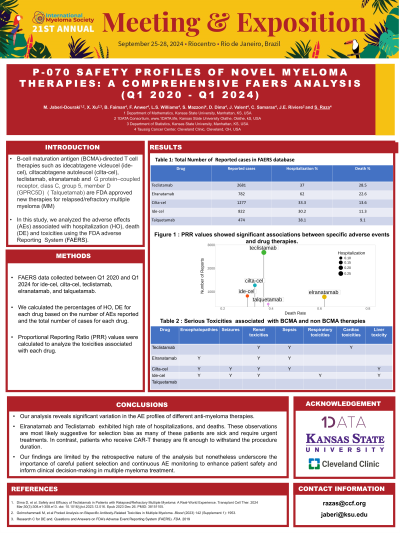Cellular and T cell engager Immunotherapy
Safety Profiles of Novel Myeloma Therapies: A Comprehensive FAERS Analysis (Q1 2020 - Q1 2024)
P-070: Safety Profiles of Novel Myeloma Therapies: A Comprehensive FAERS Analysis (Q1 2020 - Q1 2024)
Thursday, September 26, 2024


Shahzad Raza, MD (he/him/his)
Staff
Taussig Cancer Institute, Cleveland Clinic, Ohio, United States
Introduction: Understanding the safety profiles and better selection of patients for new therapies for multiple myeloma is crucial for optimizing patient care. This study examines adverse event (AE) reports associated with hospitalization (HO) and death (DE) and toxicities for several novel anti-myeloma therapies using data from the FDA Adverse Event Reporting System (FAERS).
Methods:
Methods: FAERS data collected between Q1 2020 and Q1 2024 for teclistamab, elranatamab, ciltacabtagene autoleucel (cilta-cel), idecabtagene vicleucel (ide-cel), and talquetamab were analyzed. We calculated the percentages of HO and DE for each drug based on the number of AEs reported and the total number of cases for each drug. Additionally, Proportional Reporting Ratio (PRR) values were calculated to analyze the toxicities associated with each drug.
Results: Total reported cases for each drug were: teclistamab (n=2681), elranatamab (n=782), cilta-cel (n=1277), ide-cel (n=822), and talquetamab (n=474). The percentages of hospitalizations and deaths were as follows: teclistamab: 37.0% HO, 28.5% DE; elranatamab: 62.0% HO, 22.6% DE; cilta-cel: 33.3% HO, 13.6% DE; ide-cel: 30.2% HO, 11.3% DE; and talquetamab: 38.8% HO, 9.1% DE. Notably, PRR values elucidated significant associations between specific adverse events and drug therapies. Below, we provided top 10 serious toxicities: Hepatocellular damage/hepatitis: Associated with cilta-cel, ide-cel.
Encephalopathies: Linked to cilta-cel, elranatamab, ide-cel.
Seizures: Observed with cilta-cel , ide-cel.
Renal failure: Seen in cilta-cel, elranatamab, ide-cel, teclistamab.
Sepsis: Reported with cilta-cel, elranatamab, teclistamab.
Respiratory failure: Associated with ide-cel.
Cardiac disorders: Linked to teclistamab.
Anemia: Observed with elranatamab, ide-cel, talquetamab, teclistamab.
Neutropenia: Reported with elranatamab, ide-cel, talquetamab, teclistamab.
Conclusions: This analysis reveals significant variation in the AE profiles of different anti-myeloma therapies, highlighting the need for careful patient selection, appropriate prophylaxis and close clinical monitoring. In heavily treated patients with advanced disease, Elranatamab and Teclistamab exhibited high rate of hospitalizations, and deaths. These observatiions are most likely suggestive for selection bias as many of these patients are sick and require urgent treatments. In contrast, patients who receive CAR-T therapy are fit enough to withstand the procedure duration. Our findings are limited by the retrospective nature of the analysis but nonetheless underscore the importance of careful patient selection and continuous AE monitoring to enhance patient safety and inform clinical decision-making in multiple myeloma treatment.
Methods:
Methods: FAERS data collected between Q1 2020 and Q1 2024 for teclistamab, elranatamab, ciltacabtagene autoleucel (cilta-cel), idecabtagene vicleucel (ide-cel), and talquetamab were analyzed. We calculated the percentages of HO and DE for each drug based on the number of AEs reported and the total number of cases for each drug. Additionally, Proportional Reporting Ratio (PRR) values were calculated to analyze the toxicities associated with each drug.
Results: Total reported cases for each drug were: teclistamab (n=2681), elranatamab (n=782), cilta-cel (n=1277), ide-cel (n=822), and talquetamab (n=474). The percentages of hospitalizations and deaths were as follows: teclistamab: 37.0% HO, 28.5% DE; elranatamab: 62.0% HO, 22.6% DE; cilta-cel: 33.3% HO, 13.6% DE; ide-cel: 30.2% HO, 11.3% DE; and talquetamab: 38.8% HO, 9.1% DE. Notably, PRR values elucidated significant associations between specific adverse events and drug therapies. Below, we provided top 10 serious toxicities: Hepatocellular damage/hepatitis: Associated with cilta-cel, ide-cel.
Encephalopathies: Linked to cilta-cel, elranatamab, ide-cel.
Seizures: Observed with cilta-cel , ide-cel.
Renal failure: Seen in cilta-cel, elranatamab, ide-cel, teclistamab.
Sepsis: Reported with cilta-cel, elranatamab, teclistamab.
Respiratory failure: Associated with ide-cel.
Cardiac disorders: Linked to teclistamab.
Anemia: Observed with elranatamab, ide-cel, talquetamab, teclistamab.
Neutropenia: Reported with elranatamab, ide-cel, talquetamab, teclistamab.
Conclusions: This analysis reveals significant variation in the AE profiles of different anti-myeloma therapies, highlighting the need for careful patient selection, appropriate prophylaxis and close clinical monitoring. In heavily treated patients with advanced disease, Elranatamab and Teclistamab exhibited high rate of hospitalizations, and deaths. These observatiions are most likely suggestive for selection bias as many of these patients are sick and require urgent treatments. In contrast, patients who receive CAR-T therapy are fit enough to withstand the procedure duration. Our findings are limited by the retrospective nature of the analysis but nonetheless underscore the importance of careful patient selection and continuous AE monitoring to enhance patient safety and inform clinical decision-making in multiple myeloma treatment.